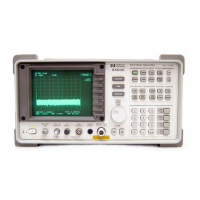632 Chapter12
Display/Power Supply Section
Display Distortion
Display Distortion
The HP 8560E uses a vector display. The graticule lines, traces, and
characters are composed of a series of straight lines ("vectors") placed
end-to-end. If the vectors do not begin and end at the proper points, the
display appears distorted, but in focus. Symptoms range from
characters appearing elongated and graticule lines not meeting
squarely, to an entirely unreadable display.
1. If the spectrum analyzer is in external frequency reference mode (an
"X" is displayed along the left side of the display), ensure that an
external 10 MHz reference is supplied. Otherwise the 16 MHz CPU
clock will be off-frequency, causing distortion.
2. Use the CRT ADJ PATTERN to check for distortion. Press
CAL,
MORE 1 OF 2, and CRT ADJ PATTERN. If vector distortion (described
above) occurs, perform the "Display Adjustment" in Chapter 2 to test
the function of the A2 controller assembly.
3. If there is distortion along with slight focus degradation, but the
graticule lines meet (not necessarily squarely), the A17 CRT driver,
CRT, DDD/TRACE ALIGN adjustments, or cable connections might
be at fault.
4. If the A2 controller assembly is not part number 08563-60017,
perform the "16 MHz PLL adjustment" in Chapter 2. If the 16 MHz
CPU clock is off-frequency, the display will be distorted.
5. Perform the "Display Adjustment" in Chapter 2. Isolate the problem
to either the X or Y axis by noting the behavior of the adjustments. If
the line generator or fast zero-span portion of the adjustment fails,
troubleshoot the A2 controller assembly.
6. If the adjustments do not remedy the problem, press
LINE to turn the
spectrum analyzer off and place the A17 CRT driver in the service
position.
7. Distortion confined to one axis (vertical or horizontal only), indicates
a faulty X or Y deflection amplifier on the A17 assembly. Use the
alternate good deflection amplifier for obtaining typical voltages.
(There is enough symmetry in a typical display that the voltages
should be similar between these circuits.)
8. Monitor the waveforms at A17TP11 and A17TP14 (or TP12 and
TP13). The 50 to 100 Vp-p ac component of the waveforms at the X
and X (or Y and Y) outputs should be mirror images of each other.
The dc average should be 55 V.
9. The appropriate POSN adjustment (A17R57 or A17R77) should
change the dc component of both X and X (or Y and Y) outputs in
opposite directions.

